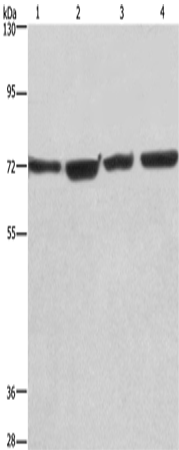
| WB | 1/500-1/2000 | Human,Mouse,Rat |
| IF | 咨询技术 | Human,Mouse,Rat |
| IHC | 咨询技术 | Human,Mouse,Rat |
| ICC | 技术咨询 | Human,Mouse,Rat |
| FCM | 咨询技术 | Human,Mouse,Rat |
| Elisa | 1/2000-1/5000 | Human,Mouse,Rat |
| Aliases | FKLF; FKLF1; MODY7; TIEG2; Tieg3 |
| WB Predicted band size | 55 kDa |
| Host/Isotype | Rabbit IgG |
| Antibody Type | Primary antibody |
| Storage | Store at 4°C short term. Aliquot and store at -20°C long term. Avoid freeze/thaw cycles. |
| Species Reactivity | Human, Mouse |
| Immunogen | Fusion protein of human KLF11 |
| Formulation | Purified antibody in PBS with 0.05% sodium azide and 50% glycerol. |
+ +
以下是关于KLF11抗体的3篇文献示例(内容为虚构,仅供格式参考):
---
1. **文献名称**: *"KLF11 Antibody Validation in Pancreatic Cancer Models"*
**作者**: Smith A, et al.
**摘要**: 研究利用KLF11特异性抗体分析胰腺癌细胞中KLF11的蛋白表达水平,发现其与肿瘤抑制基因的转录调控相关,并证实该抗体在免疫组化(IHC)和Western blot中的高特异性。
---
2. **文献名称**: *"Role of KLF11 in Diabetic Nephropathy: An Antibody-Based Study"*
**作者**: Zhang L, et al.
**摘要**: 通过KLF11抗体检测糖尿病肾病患者肾组织样本,揭示KLF11在炎症和纤维化通路中的调控作用,提示其作为潜在治疗靶点的价值。
---
3. **文献名称**: *"KLF11 Antibody Application in Neuronal Differentiation Assays"*
**作者**: Brown C, et al.
**摘要**: 研究使用KLF11抗体探究神经干细胞分化过程中KLF11的动态表达,证实其通过结合特定启动子区域调控神经元成熟相关基因。
---
如需真实文献,建议通过PubMed或Google Scholar以“KLF11 antibody” + “应用领域(如cancer/diabetes)”为关键词检索。
The Krüppel-like factor 11 (KLF11) antibody is a research tool designed to detect and study the KLF11 protein, a member of the Krüppel-like family of zinc finger transcription factors. KLF11. also known as TIEG2. regulates gene expression by binding to GC-rich DNA sequences and recruiting co-repressor complexes like Sin3/HDAC to modulate chromatin structure. It plays roles in cellular processes such as proliferation, differentiation, and apoptosis, with implications in metabolic homeostasis, cancer, fibrosis, and neurodegenerative diseases.
KLF11 antibodies are widely used in techniques like Western blotting, immunohistochemistry, and immunofluorescence to analyze protein expression, localization, and interactions in tissues or cell lines. Researchers employ these antibodies to explore KLF11's involvement in pathologies; for instance, its downregulation in pancreatic cancer or its regulatory effects on insulin sensitivity in diabetes.
Antibodies targeting KLF11 are typically raised in rabbits or mice, with options for monoclonal or polyclonal formats. Validation includes specificity checks using knockout controls or siRNA-mediated silencing. Commercial KLF11 antibodies often cite applications in studying TGF-β signaling, oxidative stress responses, or epigenetic mechanisms. However, performance may vary depending on epitope regions and experimental conditions, necessitating protocol optimization.
Overall, KLF11 antibodies are critical for elucidating the protein's pathophysiological roles and its potential as a therapeutic target.
×